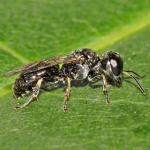Crabro anxius (WESMAEL,1852); Crabro ovatus (SCHULZ,1906); Crabro punctum (ZETTERSTEDT,1838); Crabro shuckardi (SMITH,1856)
Some authors (e.g. Lomholdt, 1984 and Dollfuss, 1991) cite the authority of this species as Lepeletier and Brullé (1834), although other works (e.g. Bitsch & Leclercq, 1993; Richards, 1980 and Fauna Europaea) favour the later publication date.
This species is reasonably common in the extreme south and south-east of England, but very much more patchily distributed across the rest of England and Wales, with only a few records for central Scotland and none for Ireland.
The species is found throughout Europe, eastwards to Kazakhstan, with an emphasis on central and northern Europe but often rather sparingly recorded.
This species is not regarded as scarce or threatened.
Potentially found in a wide variety of habitats, where suitable nesting substrates occur.
Dollfuss (1991) states May to August, although Richards (1980), referring to Britain, suggests June to September.
Hybotid flies are the usual prey, with Bitsch & Leclercq (1993) suggesting the genus Tachydromia, of which many species occur in Britain. However, Adlerz (1903, 1910) also mentions mirid bugs such as Plagiognathus chrysanthemi (Wolff) being taken. Janvier (1977) studied the species in France and found prey distributed across nine different fly families, with the majority being from the Chloropidae.
This wasp usually nests in sandy ground, but Lomholdt (1984) suggests it may also utilise very clayey soils near human habitations. The short (approximately 5cm) tunnel ends in a single cell.
No data available.
No data available.
2018


